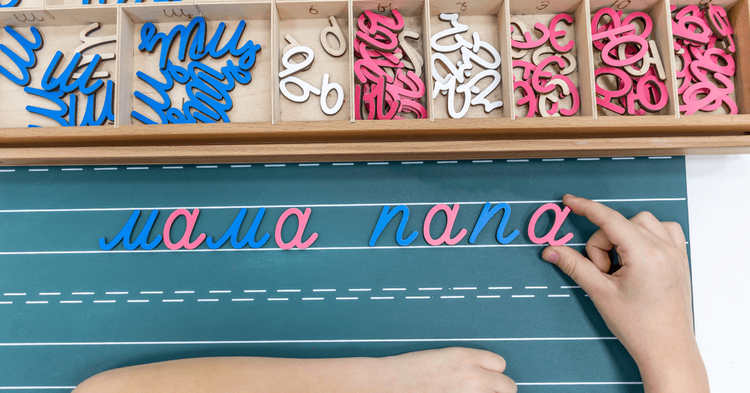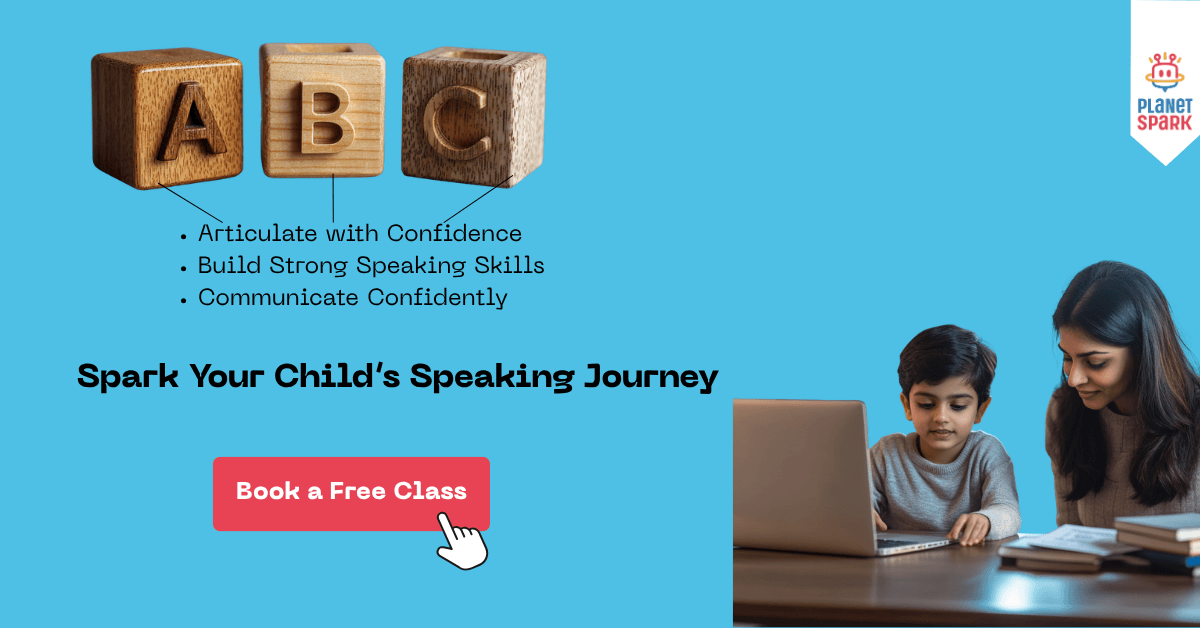Phonics Sounds & Words for Kids: A to Z English Guide | PlanetSpark

Table of Contents
- What Are Phonics Sounds?
- Phonics Sounds A to Z with Examples
- Blending and Segmenting: What Comes After Letter Sounds?
- Phonics vs. Memorization: Why Sound-Based Learning Wins
- Common Phonics Challenges
- Fun Ways to Learn Phonics Sounds A to Z
- Importance of Learning Phonics
- Phonics and Everyday Communication
- How PlanetSpark's Spoken English Course Makes Phonics Come A
- Why Start Phonics Early?
- Conclusion
- FAQs About Phonics Sounds A to Z
If your child is learning to speak, read, or write in English, mastering phonics sounds A to Z is the best place to start. Phonics helps children connect the letters of the alphabet with their respective sounds, enabling them to read unfamiliar words, speak more clearly, and build confidence in communication.
PlanetSpark integrates phonics training into our spoken English course through live interactive sessions, AI pronunciation tools, and real-life conversation practice so your child doesn’t just learn sounds, but uses them fluently every day.
Let’s dive into the world of phonics A to Z, understand each sound, and explore how it lays the foundation for effective spoken English.
What Are Phonics Sounds?
Phonics refers to the method of teaching children how to connect the sounds (phonemes) of spoken English with the letters (graphemes) of written English. These basic letter-sound relationships allow children to decode and pronounce new words.
For example:
The letter “A” makes the /æ/ sound as in apple.
The letter “B” makes the /b/ sound as in ball.
By mastering the phonics sounds A to Z, children can begin to:
Recognize letter-sound associations
Sound out unfamiliar words
Speak with correct pronunciation
Gain confidence in reading aloud and communicating

Phonics Sounds A to Z with Examples
Below is a breakdown of the 26 letters and their most common phonics sounds:
| Letter | Phonic Sound | Example Word |
|---|---|---|
| A | /æ/ | Apple |
| B | /b/ | Ball |
| C | /k/ | Cat |
| D | /d/ | Dog |
| E | /ɛ/ | Elephant |
| F | /f/ | Fish |
| G | /g/ | Goat |
| H | /h/ | Hat |
| I | /ɪ/ | Ink |
| J | /ʤ/ | Jug |
| K | /k/ | Kite |
| L | /l/ | Lion |
| M | /m/ | Monkey |
| N | /n/ | Nest |
| O | /ɒ/ or /ɑː/ | Orange / Octopus |
| P | /p/ | Pen |
| Q | /kw/ | Queen |
| R | /r/ | Rabbit |
| S | /s/ | Sun |
| T | /t/ | Tiger |
| U | /ʌ/ | Umbrella |
| V | /v/ | Van |
| W | /w/ | Watch |
| X | /ks/ | Box |
| Y | /j/ | Yak |
| Z | /z/ | Zebra |
Learn the basics of sounds with Phonics Classes for Class 1
Blending and Segmenting: What Comes After Letter Sounds?
Learning individual phonics sounds A to Z is only the beginning. The next step is blending these sounds to form words and segmenting words into their component sounds.
Blending Example:
/c/ + /a/ + /t/ = cat
Segmenting Example:
dog → /d/ + /ɒ/ + /g/
Phonics vs. Memorization: Why Sound-Based Learning Wins
Memorizing words can be overwhelming for kids, especially when English spelling can be tricky. Phonics gives kids tools to figure out any new word independently.
Instead of memorizing "cake," a child learns:
/c/ + /æ/ + /k/ + magic e = cake
This sound-first approach results in:
Faster learning
Clearer speech
Greater vocabulary
Common Phonics Challenges
1. Mother Tongue Influence (MTI)
One of the most common barriers in spoken English is Mother Tongue Influence (MTI) a subtle yet powerful force that can affect pronunciation, intonation, and even fluency. Children often carry over sounds, speech patterns, and rhythm from their native language into English without realizing it. This can make their speech hard to understand and impact their confidence during conversations.
2. Difficulty Differentiating Similar Sounds
English is filled with subtle sound differences that can be tough for young learners to grasp especially if those sounds don’t exist in their native language. For instance, the distinction between /s/ and /ʃ/ (as in sun vs shoe), or /b/ and /v/ (bat vs van), can easily get blurred. Mispronunciation of such sounds not only affects clarity but can also lead to misunderstandings and reduced confidence.
3. Shyness in Speaking Aloud
Even after mastering phonics and pronunciation, many children hold back from speaking in public. Shyness, fear of being wrong, or simply a lack of opportunity to express themselves can keep their progress hidden. This hesitation often leads to underdeveloped speaking skills and poor classroom participation.
From A for Apple to Z for Zebra, We Make Every Sound Speak Loud!
Book a FREE trial class and experience how phonics fuels real fluency
Fun Ways to Learn Phonics Sounds A to Z

Phonics is the building block of confident reading and clear speaking. But for children, learning phonics shouldn’t feel like memorizing a chart it should be an exciting discovery of how sounds turn into words!
Here are some fun, practical, and research-backed ways to help kids learn phonics sounds from A to Z with joy and confidence.
- Phonics Songs & Rhymes: Music has a magical way of making learning stick. Phonics songs and rhymes transform abstract letter sounds into catchy, memorable tunes. For instance, singing “A is for apple /æ/, B is for ball /b/...” introduces each letter-sound pair with rhythm and repetition.
Bonus Benefit: Songs also help with intonation and fluency, crucial for speech development.
- Letter-Sound Matching Games: Visual learners thrive when they can see and touch what they’re learning. Letter-sound matching games make this possible. Children match a letter (like B) to a corresponding image (ball) and then say the sound aloud (/b/).
Why it works: This multi-sensory approach activates both visual and auditory memory boosting retention.
- Online Phonics Games: Children love to play and when learning feels like play, they stay engaged longer. Gamified phonics tools, such as Kahoot quizzes, spelling races, sound mazes, and alphabet puzzles, add an element of fun and competition.
PlanetSpark’s learning ecosystem includes real-time phonics games where kids:
Race to build words from sounds
Identify the odd sound out
Match rhyming pairs or syllables
These games are customized by age and phonics level, making them both challenging and rewarding. They also build attention span, quick recall, and application of phonics rules in real-world speaking and reading.
Learning Tip: Gamification increases dopamine levels, which makes children feel good about learning—and want to keep going.
- Tactile Activities for Kinesthetic Learners" For hands-on learners, tactile phonics activities are incredibly effective. These involve engaging the sense of touch while learning sounds. Some favorite activities include:
Molding letters with clay and vocalizing their sounds
Tracing letters on sandpaper while saying them aloud
Tapping out syllables or segmenting sounds on a table
Also, join the platforms to get Online English Phonics Level 1 Training for Children
At PlanetSpark, we often recommend these exercises as part of our offline activity kits and home practice assignments. When children use their hands, their muscle memory kicks in, strengthening their ability to recall letter shapes and sounds.
Not Just Phonics. Future-Ready Communication.
With PlanetSpark, your child doesn’t just learn sounds they speak them with style and confidence.
Book a free demo class to join today!
5. Story Time with Sound Emphasis
Reading isn’t just about comprehension it’s also a brilliant opportunity for phonic reinforcement. During story time, PlanetSpark trainers emphasize beginning and target sounds as they narrate. For example:
“The b-b-boy bounced the b-b-big blue ball.”
This method helps children tune in to the sounds within words, understand how phonics works in context, and mimic correct pronunciation. Trainers also pause and prompt students to repeat or identify words with similar sounds, turning every story session into a phonics lab in disguise.
Added Bonus: Children expand vocabulary while reinforcing pronunciation and phoneme awareness.
6. Speak-and-Record Tools with AI Feedback
Self-correction is a powerful tool especially when supported by smart technology. At PlanetSpark, kids use AI-powered fluency tools that allow them to:
Record their voice
Listen back to their own speech
Receive real-time pronunciation scores and suggestions
This turns phonics into a self-guided speech coaching experience. Children become more aware of how they sound, where they’re making errors, and how to correct themselves. They learn to monitor clarity, pitch, speed, and intonation.
Try This at Home: Turn your home into a sound-lab. Ask your child, “Can you find something that starts with the sound /d/?” Let the phonics hunt begin!
Importance of Learning Phonics
Phonics is not just a reading technique; it’s a powerful language skill that lays the groundwork for fluency, comprehension, and confident communication. Here’s why phonics should be a part of every child’s early education:
- Connects Letters to Sounds: Phonics teaches children that letters represent sounds. This basic understanding empowers them to read, speak, and write independently.
- Boosts Reading Fluency: When kids recognize sounds and blend them into words, they read faster, smoother, and with better understanding.
- Improves Spelling: A strong foundation in phonics helps children decode and encode words accurately, enhancing spelling skills naturally.
- Strengthens Listening and Pronunciation: Through phonics, children learn how words should sound, which sharpens their auditory discrimination and clarifies their speech.
- Builds Communication Confidence: A child who can decode words confidently is more likely to speak up, read aloud, and engage in conversations a key goal of PlanetSpark’s Spoken English course.
Phonics and Everyday Communication

Knowing phonics isn’t just for school it’s for life. Here’s how phonics powers real-life communication:
Clearer Pronunciation
Children pronounce words correctly when they understand how each sound is formed. Phonics makes speech clear and confident.
Faster Word Recall
Phonics training improves decoding skills, so when a child hears a new word, they can figure out how to say it—and remember it better.
Stronger Vocabulary
As kids learn to read through phonics, they’re exposed to more words—automatically expanding their vocabulary.
Better Peer Conversations
From playdates to class discussions, kids who master phonics can express themselves better and connect socially with ease.
Every sound is a step toward fluent conversation.
PlanetSpark makes phonics fun, interactive, and powerful.Try a live demo class and hear the difference!
How PlanetSpark's Spoken English Course Makes Phonics Come Alive
PlanetSpark is not just another learning platform it’s an immersive speaking environment that makes phonics practice natural, engaging, and result-driven.
Here’s how our course stands out:
- Live, Interactive English Conversations: Every day includes phonics reinforcement through live speaking practice, ensuring kids retain and apply sounds contextually.
- Accent Neutralization & Pronunciation Focus: Dedicated phonics and pronunciation modules help children articulate clearly, confidently, and globally.
- Situational Role Plays: Whether it’s ordering at a restaurant or introducing themselves, kids learn to use phonics-learned words in real situations.
- Instant Feedback & AI Reports: Children receive instant, detailed feedback on pronunciation errors, fluency, and articulation.
- Speaking Confidence Trackers: Progress is monitored through audio-visual recordings, allowing personalized coaching for every learner.
Why Start Phonics Early?
Children aged 3 to 8 are in their prime language acquisition window. Introducing phonics sounds A to Z during this phase helps:
Build lifelong reading fluency
Boost vocabulary and sentence structure
Improve pronunciation and comprehension
Prepare for academic and public speaking success

Conclusion
Understanding phonics sounds A to Z is like giving your child the keys to a world of confident speaking, expressive reading, and clear communication.
At PlanetSpark, we don’t stop at sounds we turn them into sentences, stories, and speeches. Through our interactive classes, real-time feedback, and phonics-powered fluency tools, your child becomes a bold and clear communicator ready for any challenge.
FAQs About Phonics Sounds A to Z
Q1. At what age should my child start learning phonics?
A: Children can begin learning phonics as early as age 3, when their brains are highly receptive to new sounds and language patterns. Early phonics exposure lays a strong foundation for reading, speaking, and listening skills. At this stage, learning is play-based and sound-driven helping children develop phonemic awareness naturally and joyfully.
Q. How are phonics and spoken English connected?
A: Phonics is the backbone of spoken English. It helps children understand how letters and sounds relate making it easier to pronounce words accurately. Without phonics, kids may learn to read by sight but struggle with articulation, fluency, and speech clarity.
Q. Are phonics just for reading or also speaking?
A: While phonics is often introduced for reading, it is equally critical for speaking. Understanding the connection between letters and their corresponding sounds empowers children to:
Decode new words confidently
Pronounce words correctly
Speak clearly and fluently
Q. How long does it take to master phonics sounds A to Z?
A: With consistent daily practice, most children can master the A to Z phonics sounds within 2–3 months. The timeline varies depending on:
The child’s age and exposure to English
The frequency of practice
The quality of trainer feedback and guidance
PlanetSpark accelerates this process through AI-supported feedback, engaging repetition techniques, and multisensory activities that speed up phonics retention and pronunciation accuracy.
Q. How do you teach phonics sounds A to Z?
A: Teaching phonics A to Z requires a structured, multi-sensory approach. These steps can be followed to teach systematically:
Introduce Letter Sounds Gradually: Starting with commonly used consonants and short vowels (e.g., /s/, /a/, /t/).
Use Visual & Audio Aids: Flashcards, phonics songs, and real-life object examples.
Practice Blending: Teach children how to blend letter sounds (e.g., c-a-t → cat).
Apply in Speaking & Reading: Kids practice these sounds during live reading, storytelling, and AI-recorded speech drills.
Reinforce with Games & Activities: Matching games, phonics mazes, and hands-on clay modeling.
This method ensures that children don’t just learn phonics they internalize them.
Q. What are the 42 phonics sounds A to Z?
A: The 26 letters of the alphabet represent 42 phonics sounds, including:
19 consonant sounds (e.g., /b/, /d/, /k/)
5 short vowel sounds (e.g., /a/ as in cat)
5 long vowel sounds (e.g., /aɪ/ as in bike)
8 digraphs (e.g., /sh/, /ch/, /th/)
Here’s a sample breakdown:
/a/ – apple
/b/ – ball
/ch/ – chip
/ee/ – feet
/ng/ – ring
/ow/ – cow
/th/ – thin (voiceless)
/th/ – that (voiced)
These sounds are foundational to decoding, pronunciation, and fluent reading. PlanetSpark covers all 42 sounds through systematic phonics modules.
Q. What are the 44 phonics sounds in English?
A: English has 44 distinct phonics sounds, categorized as:
20 vowel sounds (short, long, diphthongs)
24 consonant sounds
These sounds include blends and digraphs such as:
/sh/ – ship
/oi/ – coin
/ar/ – car
/igh/ – light
/air/ – hair
Understanding all 44 sounds helps children develop advanced reading and speaking fluency. PlanetSpark breaks these sounds into manageable levels so kids progress step by step from beginner to advanced phonics.
Q. What are 5 examples of phonics sounds?
A: Here are 5 commonly taught phonics sounds with examples:
/s/ – sun, sip, sit
/a/ – apple, ant, axe
/t/ – tap, ten, top
/m/ – man, map, mop
/ee/ – see, tree, feet
These sounds represent single-letter or digraph phonemes, which form the core of beginner phonics lessons. At PlanetSpark, these are introduced through interactive games, stories, and articulation practice to make learning natural and exciting.
Download Free Worksheets
Personalized Communication Report
Record a video to get a AI generated personalized communication report for your child

Hi There, want to try these
tips for your child with
LIVE with our expert coach?
Let's check your child's
English fluency


